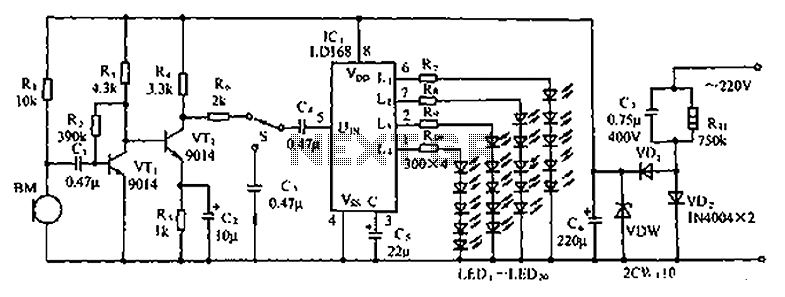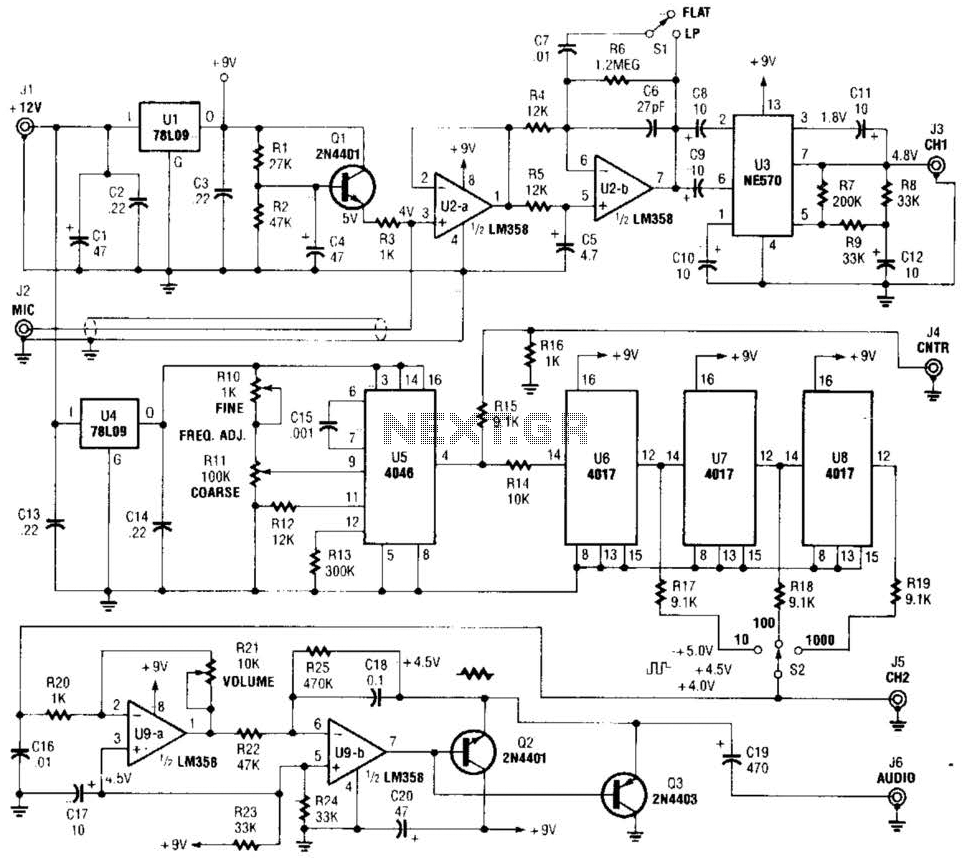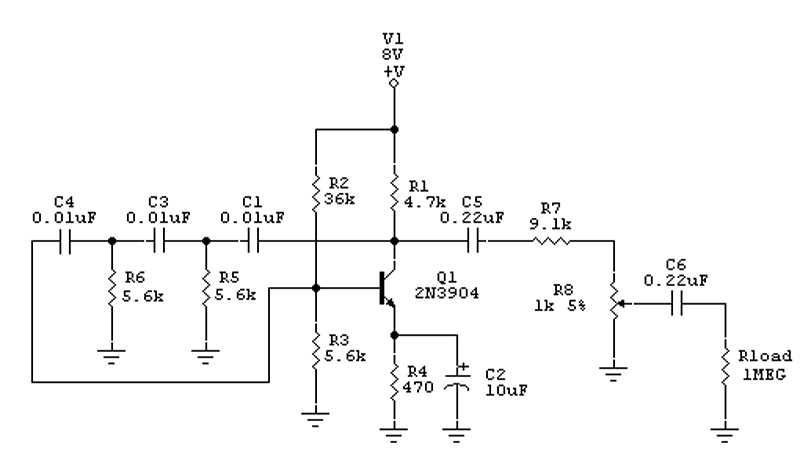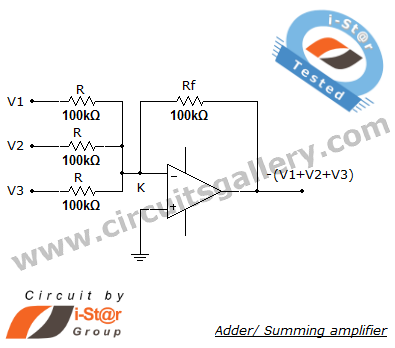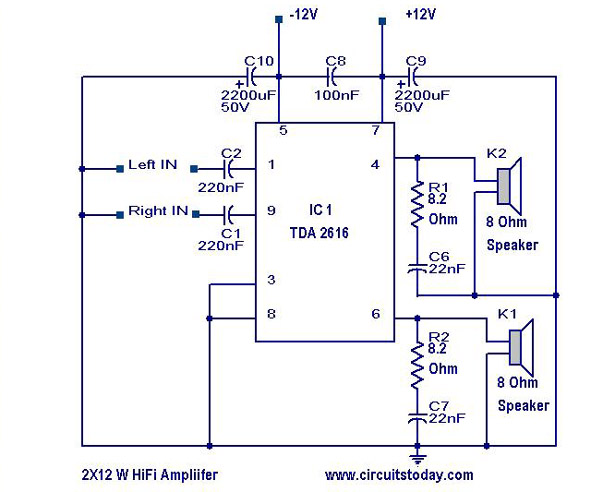
25 Watt Audio Amplifier
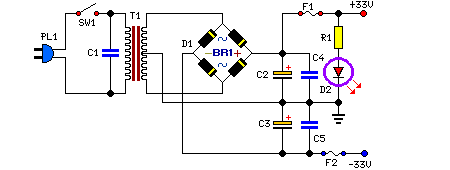
This is a 25 Watt basic power amplifier designed to be relatively easy to build at a reasonable cost. It offers better performance than standard STK module amplifiers commonly found in mass-market stereo receivers. The original design was created to fulfill the need for a 25 Watt amplifier for personal computer use without incurring significant expenses, utilizing parts readily available. The amplifier can be directly connected to CD players, tuners, and tape recorders. A 10K logarithmic potentiometer (dual gang for stereo) and a switch are required to manage various audio sources. Proper grounding is critical to eliminate hum and ground loops; it is recommended to connect the ground sides of resistors R1, R4, R9, and capacitors C3 to C8 to a common ground point. Capacitor C11 should be connected to the output ground, and the input and output grounds must be separately connected to the power supply ground.
The 25 Watt power amplifier circuit utilizes a straightforward design that facilitates assembly and component sourcing. The core of the amplifier typically comprises a transistor-based output stage, which may include complementary push-pull configurations to enhance efficiency and reduce distortion. The input stage is designed to accommodate various audio sources, ensuring compatibility with standard consumer electronics.
The inclusion of a 10K logarithmic potentiometer allows for smooth volume control, providing a user-friendly interface for adjusting audio levels. The dual gang configuration ensures that both left and right channels in stereo applications are adjusted simultaneously, maintaining balance and sound integrity.
Grounding is a critical aspect of audio amplifier design. The recommended grounding scheme helps to mitigate potential issues related to electromagnetic interference and ground loops, which can introduce unwanted noise into the audio signal. By connecting specific components to a common ground point and ensuring that input and output grounds are isolated from the power supply ground, the design minimizes the risk of hum and enhances overall sound quality.
In terms of power supply requirements, the amplifier should be paired with a suitable transformer and rectifier circuit to provide the necessary voltage and current levels for optimal performance. The circuit design must also account for adequate heat dissipation, potentially incorporating heat sinks for the output transistors to prevent thermal overload during extended use.
Overall, this 25 Watt power amplifier represents a practical solution for audio amplification needs, combining ease of construction, cost-effectiveness, and superior performance compared to conventional amplifier modules.This is a 25 Watt basic power amp that was designed to be (relatively) easy to build at a reasonable cost. It has better performance than the standard STK module amps that are used in practically every mass market stereo receiver manufactured today.
When I originally built this thing, it was because I needed a 25 Watt PC amp and did not want to sp end any money. So I designed around parts I had in the shop. Can be directly connected to CD players, tuners and tape recorders. Simply add a 10K Log potentiometer (dual gang for stereo) and a switch to cope with the various sources you need. A correct grounding is very important to eliminate hum and ground loops. Connect to the same point the ground sides of R1, R4, R9, C3 to C8. Connect C11 to output ground. Then connect separately the input and output grounds to power supply ground. 🔗 External reference
The 25 Watt power amplifier circuit utilizes a straightforward design that facilitates assembly and component sourcing. The core of the amplifier typically comprises a transistor-based output stage, which may include complementary push-pull configurations to enhance efficiency and reduce distortion. The input stage is designed to accommodate various audio sources, ensuring compatibility with standard consumer electronics.
The inclusion of a 10K logarithmic potentiometer allows for smooth volume control, providing a user-friendly interface for adjusting audio levels. The dual gang configuration ensures that both left and right channels in stereo applications are adjusted simultaneously, maintaining balance and sound integrity.
Grounding is a critical aspect of audio amplifier design. The recommended grounding scheme helps to mitigate potential issues related to electromagnetic interference and ground loops, which can introduce unwanted noise into the audio signal. By connecting specific components to a common ground point and ensuring that input and output grounds are isolated from the power supply ground, the design minimizes the risk of hum and enhances overall sound quality.
In terms of power supply requirements, the amplifier should be paired with a suitable transformer and rectifier circuit to provide the necessary voltage and current levels for optimal performance. The circuit design must also account for adequate heat dissipation, potentially incorporating heat sinks for the output transistors to prevent thermal overload during extended use.
Overall, this 25 Watt power amplifier represents a practical solution for audio amplification needs, combining ease of construction, cost-effectiveness, and superior performance compared to conventional amplifier modules.This is a 25 Watt basic power amp that was designed to be (relatively) easy to build at a reasonable cost. It has better performance than the standard STK module amps that are used in practically every mass market stereo receiver manufactured today.
When I originally built this thing, it was because I needed a 25 Watt PC amp and did not want to sp end any money. So I designed around parts I had in the shop. Can be directly connected to CD players, tuners and tape recorders. Simply add a 10K Log potentiometer (dual gang for stereo) and a switch to cope with the various sources you need. A correct grounding is very important to eliminate hum and ground loops. Connect to the same point the ground sides of R1, R4, R9, C3 to C8. Connect C11 to output ground. Then connect separately the input and output grounds to power supply ground. 🔗 External reference
